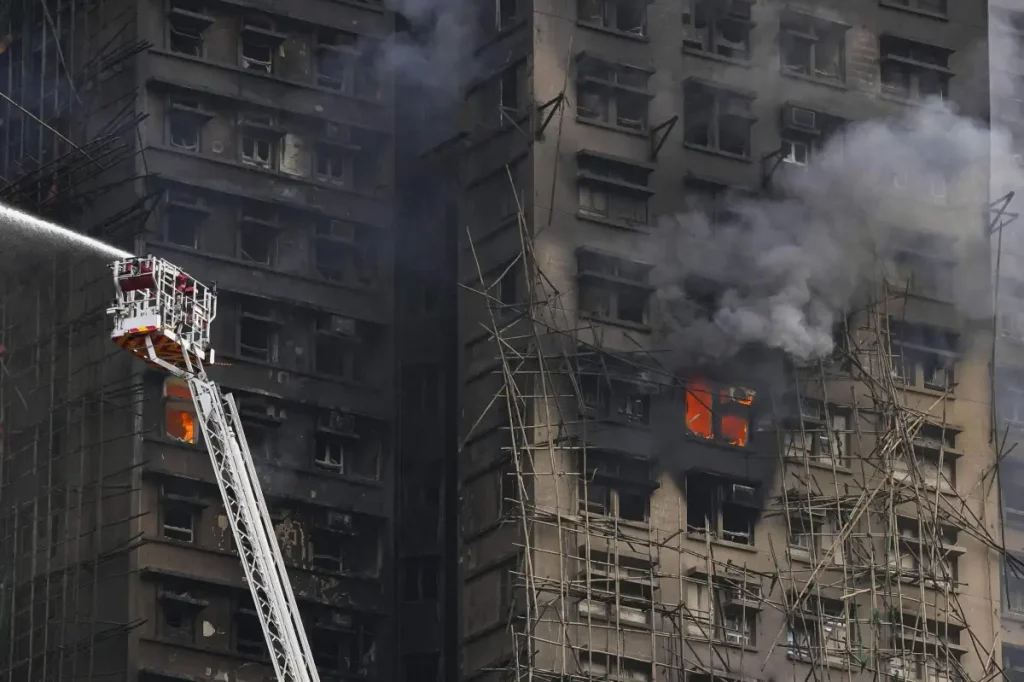Tragedy in Hong Kong: Deadliest Fire in Decades Claims Nearly 100 Lives
The serene community of Tai Po in Hong Kong has been devastated by an unprecedented tragedy that has left the city in mourning. A catastrophic fire that engulfed the Wang Fuk Court apartment complex has claimed at least 94 lives, making it Hong Kong’s deadliest blaze in over seven decades. The disaster, which began Wednesday when flames erupted on bamboo scaffolding surrounding the 1980s-era buildings, quickly spread across seven of the eight 32-story towers that housed approximately 4,800 residents. As smoke continues to rise from the charred structures on the third day, firefighters are making a final desperate push to locate survivors among the dozens still listed as missing, with the official rescue phase scheduled to conclude Friday.
“Our firefighting operation is almost complete,” said Derek Armstrong Chan, Deputy Director of the Hong Kong Fire Services, as more than 1,000 firefighters worked tirelessly through the disaster. The challenges they faced were immense – rapidly spreading flames, falling bamboo scaffolding, and debris that blocked emergency vehicles from reaching those trapped inside. The fire’s exceptional speed caught many residents off guard, including Lawrence Lee, who recounted his wife’s harrowing experience: “When the fire started, I told her on the phone to escape. But once she left the flat, the corridor and stairs were all filled with smoke and it was all dark, so she had no choice but to go back to the flat.” This scenario likely played out hundreds of times throughout the complex, with authorities previously reporting 279 missing persons after communication was lost. The human toll has been devastating – beyond the confirmed deaths, more than 70 people have been injured, including 11 firefighters who risked their lives battling the inferno.
The magnitude of this disaster has prompted swift action from authorities, with Hong Kong’s Chief Executive John Lee establishing a special investigation team to determine the cause. Police have already arrested three men – two directors and an engineering consultant from a construction company – on suspicion of manslaughter. “We have reason to believe that those in charge of the construction company were grossly negligent,” explained Senior Superintendent Eileen Chung. Investigators raided the offices of Prestige Construction & Engineering Company, the firm overseeing renovations at the complex, seizing boxes of documents for review. Authorities suspect that non-compliant materials used on the exterior walls may have accelerated the fire’s spread, and Hong Kong’s anti-corruption agency has launched a separate probe into potential corruption in the renovation project, underscoring the serious regulatory concerns the tragedy has raised.
This catastrophe, while shocking in its scale, fits into a sorrowful history of deadly fires in Hong Kong. Though it surpasses the 1996 Kowloon fire that killed 41 people, it remains below the devastating toll of the 1918 Happy Valley Fire that claimed over 600 lives and the 1948 warehouse fire that resulted in 176 deaths. The Wang Fuk Court fire has been particularly traumatic for a community accustomed to modern safety standards, leaving hundreds displaced and approximately 900 people housed in temporary shelters overnight. The scenes of desperate families awaiting news of loved ones have touched the city profoundly, as has the heroism of first responders who continued to battle small flare-ups even days after the initial blaze. The fire’s impact extends beyond the immediate casualties, creating a ripple effect of trauma throughout Hong Kong society and raising urgent questions about construction safety practices.
The tragedy is likely to accelerate Hong Kong’s planned transition away from traditional bamboo scaffolding – a 1,000-year-old construction technique that has been part of the city’s iconic skyline. Eric Chan, Chief Secretary for Administration, acknowledged this shift, noting, “While we know that bamboo scaffolding has a long history in Hong Kong, its flame retardancy is inferior to that of metal scaffolding. For safety reasons, the government believes that a complete switch to metal scaffolding should be implemented in suitable working environments.” This evolution, while respecting cultural heritage, prioritizes modern safety standards that might have prevented or mitigated the Wang Fuk Court disaster. Meanwhile, authorities have launched immediate safety reviews of other housing estates undergoing renovation to prevent similar tragedies, with particular attention to scaffolding materials and fire prevention protocols.
As the rescue phase concludes and investigations deepen, Hong Kong faces a period of mourning, reflection, and eventual rebuilding. The death toll may yet rise as firefighters complete their final searches of the complex. For survivors, the trauma of lost homes, possessions, and worst of all, loved ones, will require long-term support from both government agencies and the broader community. The Wang Fuk Court fire will likely lead to significant regulatory changes in Hong Kong’s construction industry, particularly regarding renovation practices for older buildings. In the words of a spokesperson for Hong Kong’s Independent Commission Against Corruption, the “immense public interest” in this case demands thorough investigation of every aspect of the project that led to such devastating consequences. As the city processes this collective trauma, the focus will inevitably shift toward ensuring that lessons learned from this tragedy result in stronger protections for all Hong Kong residents.


